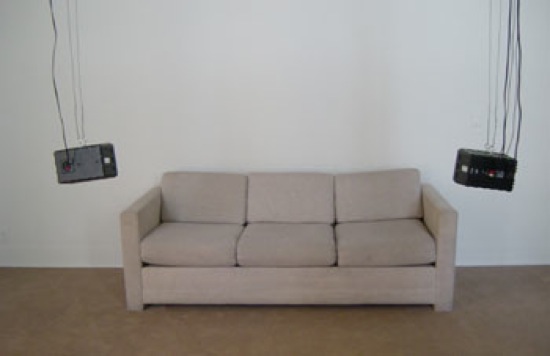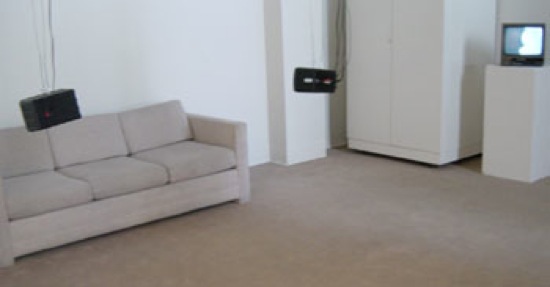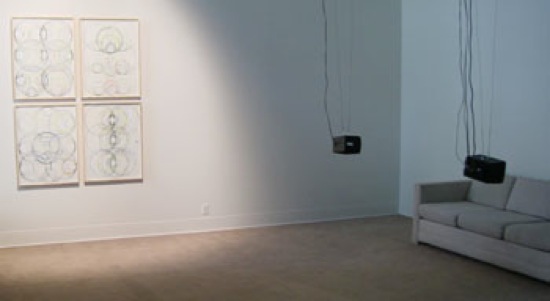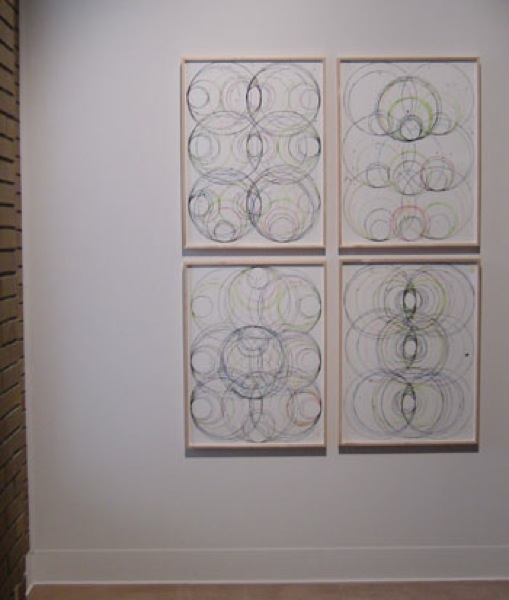2003
stereo sound installation
super 8 film loop (transferred to video)
4 ink drawings
chamber music was an installation that consisted of a sound work, a series of drawings, and a short silent film. all of the works were inspired by the work of luke howard, an amateur meteorologist who created the system of cloud names in the early 1800’s that are still in use today.
the works translate various lists of cloud types into sound, drawings, and film. the three pieces were born from the same source materials and inspiration, yet exist independent of each other in the space so that each must be perceived from a different vantage point in the gallery space.
chamber music was one of the first bodies of work where individual works in various mediums were all birthed from the same source.
because the gallery at jack straw consisted of a couch, carpeted floor and windows, the scale of the works were domestic.
here is a text about the works from 2003:
chamber music
drifting –
a few years ago, while scrounging around a used bookstore out near joshua tree california, i found a 1950’s book of photographs of clouds for airplane viewing. i had tried to force the book into my work a number of times, but it simply never felt right. when i began to think about an installation for jack straw, i began to think again about clouds and the cloud book – this time gravitating towards the lists and charts in the back of the book as opposed to the photos as possible source material. as the main list of cloud types consisted of only 10 names, i decided to use the internet to search for a list of all the scientific terms used to describe cloud types. i ended up on a website devoted to luke howard – the amateur meteorologist who, in the early 1800’s, invented the terms ‘cumulus’ ‘cirrus’ ‘stratus’ etc. i also discovered that his work was inspirational to goethe – a perfect melding of science and art – one inspiring the other and back again. so i followed my path of cloud watching, with one foot comfortably resting in the scientific terminology, and the other foot resting on the poetic inspirations that followed…
shadows (an aside) –
whenever i speak or hear the word ‘cloud’, i tend to follow it with the word ‘chamber’ – for some reason, these two words, are linked together in my own mind’s word association table. perhaps it is because of harry partch -certainly the sound of and even the names of his cloud chamber bowls have always conjured up images for me that are inspirationally rich. and then there is the association with the word ‘chamber’ that sends me back to alvin lucier – his wonderful texts, and his work of the same name – two people that i would never consider placing my own work alongside of; or contextualizing my own work amongst – yet two precedents as well as inspirations that must be mentioned. it is a simple fact that when one plays a glass bowl; one sounds in partch’s shadow; and likewise when one listens to the resonance of a teacup; one listens in lucier’s shadow.
the music –
the sound work was created as a kind of translation of the 10 basic family names of clouds. from the list of names, i figured out how many different letters total were present – 12. i then gathered 12 resonant chambers from my house -glass bowls, ceramic cups, tin light shades – anything that resonated when struck and had an empty space inside of it. each of the 12 chambers stood in for a letter of the alphabet. i then broke the words on the list down into a list of the 12 different letters, with a number for how many times that letter appeared – for example in the 10 names there were 7 A’s, 2 B’s, etc. through these kind of arbitrary calculations, i arrived at a place where i could use the sound generated by the A chamber for 7 minutes, the B chamber for 2 minutes and so on. thus, the composition was created using a structuring principle based on a literal translation of all the letters in the list of the 10 family names of clouds. i should mention that even though i feel that the entire list of names is physically present in the piece; i also feel that the final result has little to do with cloud names- one certainly will not be able to sit there and listen and hear the broken names of clouds passing gently by their ears. the process simply allows a set of parameters to formally bring the work into existence. the finished audio hopefully transcends the method of its making to a place of pure experience; where one can simply wander around and get lost within it. as a sound artist i am interested not so much in compositional process (although an investigation of process is a huge part of my working practice) – as i am interested in the creation of simple ‘listening sites’- where one is drawn into the quietly repetitive audio space as a dreamer, a thinker, or an active listener.
the drawings –
aside from the 10 basic cloud families, i found 3 other main catagories: species, varieties, and accessory clouds. when i finished working with the chambers for the sound work, i took the family names, species, varieties, and accessory cloud lists and again, found the total number of different letters in the entire list of 42 terms. since there were more letters than in the soundwork, i found some other chambers in the house. these, of course, were silent in relation to the audio piece; but added to the original 12 chambers to complete a visual alphabet of possible sounding presences. the total number of objects (and letters) was up to 18. i took each of the 18 objects and traced its circular opening onto a piece of cardboard and then created a stencil of the outer ‘trace’ of each of the chambers/letters. i then assigned each letter an ink color. the four drawings consist of a translation of every one of the 42 terms on the 4 lists – hence the title “every name of every cloud in every sky”. as with the soundwork the drawing is not intended as a readable listing of terms, but becomes about the experience of taking specific language and sending it through a process or system in order to open it up so that it can exist as a simple abstract presence -again, open to an experience visual wandering.
the film –
the film takes the traces of the 18 chambers/letters as well as the lists of total terms; and once again attempts to open them up to new meanings and readings. the film opens with text from a poem by shelley about clouds, the middle section has descriptive text (which turns out to be beautifully poetic) from one of howard’s lists of cloud terms; and the end is the last line of one of goethe’s poems that was dedicated to howard. the film uses imagery from the traces of chambers, as well as the stencils themselves. images moving and drifting through time, in reference to, but not connected through absolute description to, the drifting and morphing of clouds into images – and similarly from poetry to science and back again.
in the end, science is used as a trigger for abstract thought and an attempt to get at a kind of pure experience – a pure experience that comes not from a lack of knowledge; but through a process of dissolving knowledge and facts so that their edges become fuzzy and open to a variety of interpretations, experiences, and wanderings.



